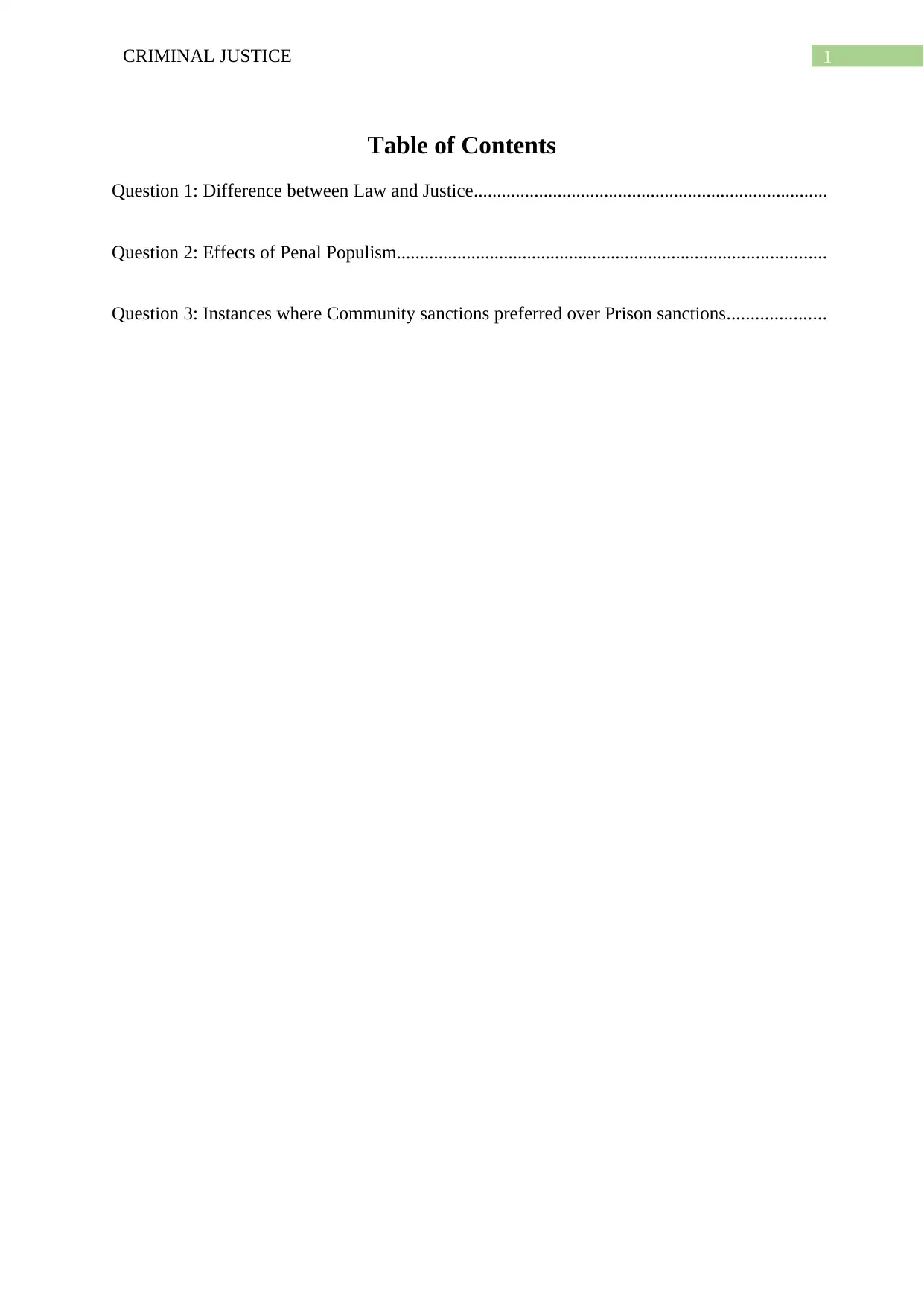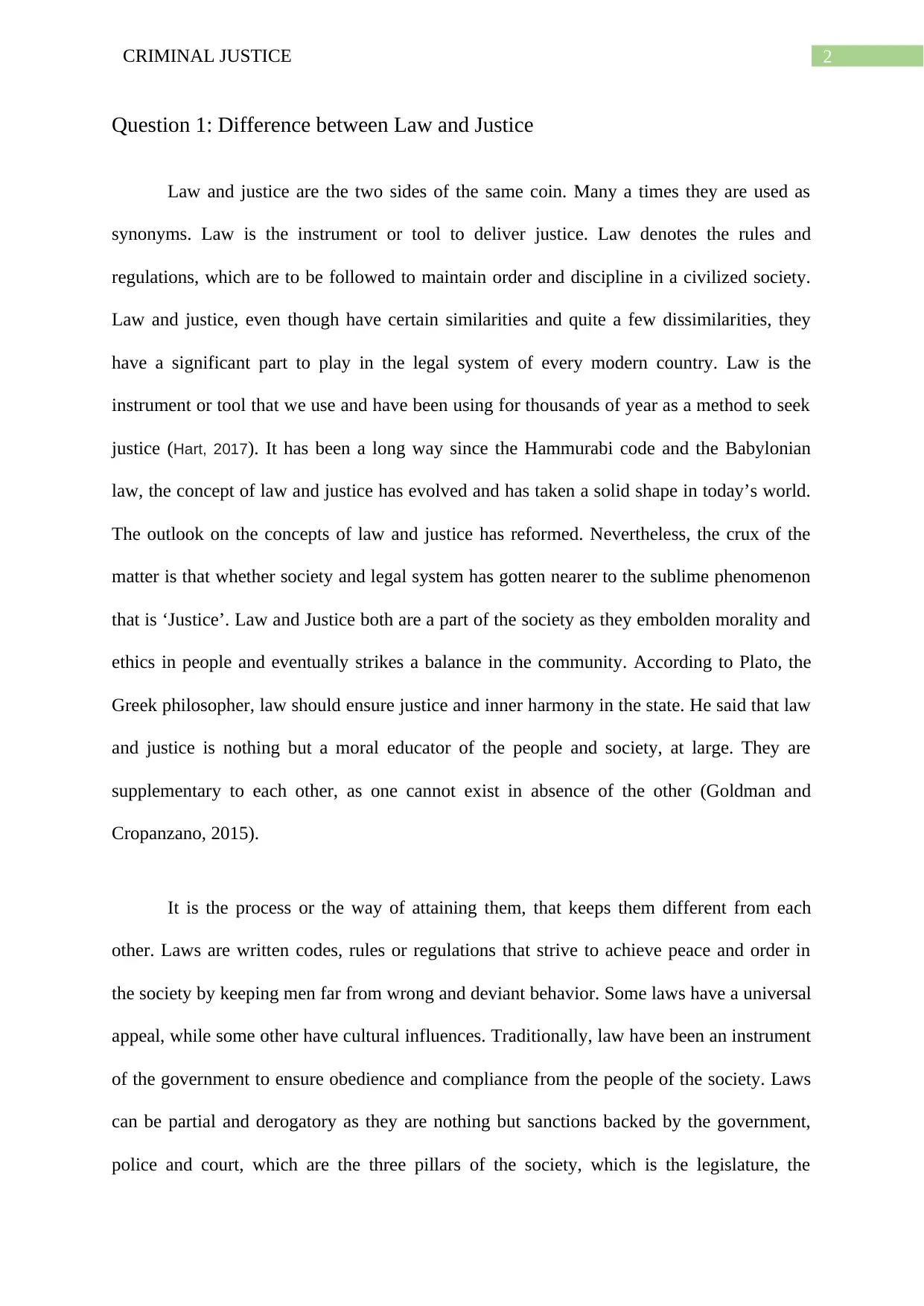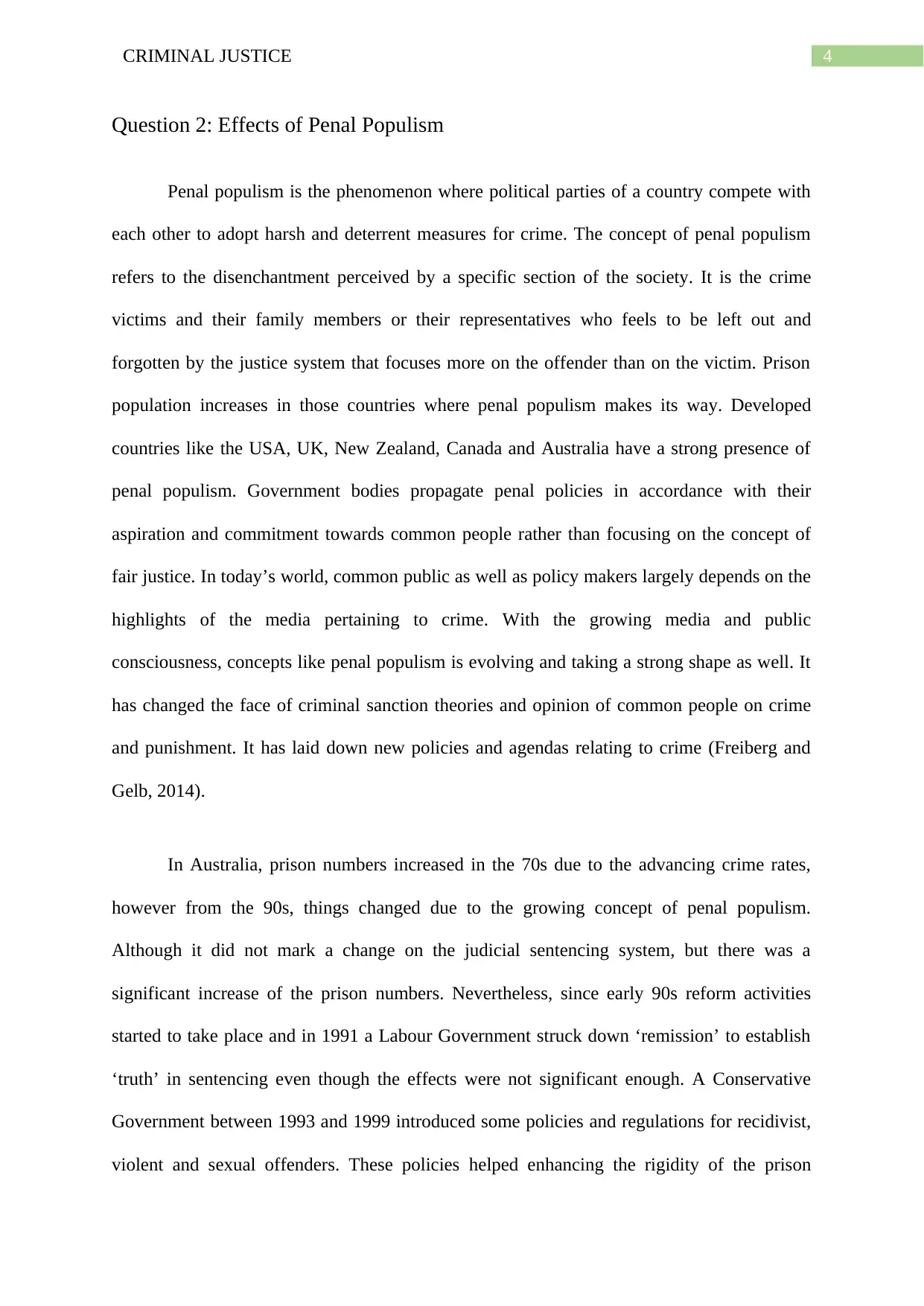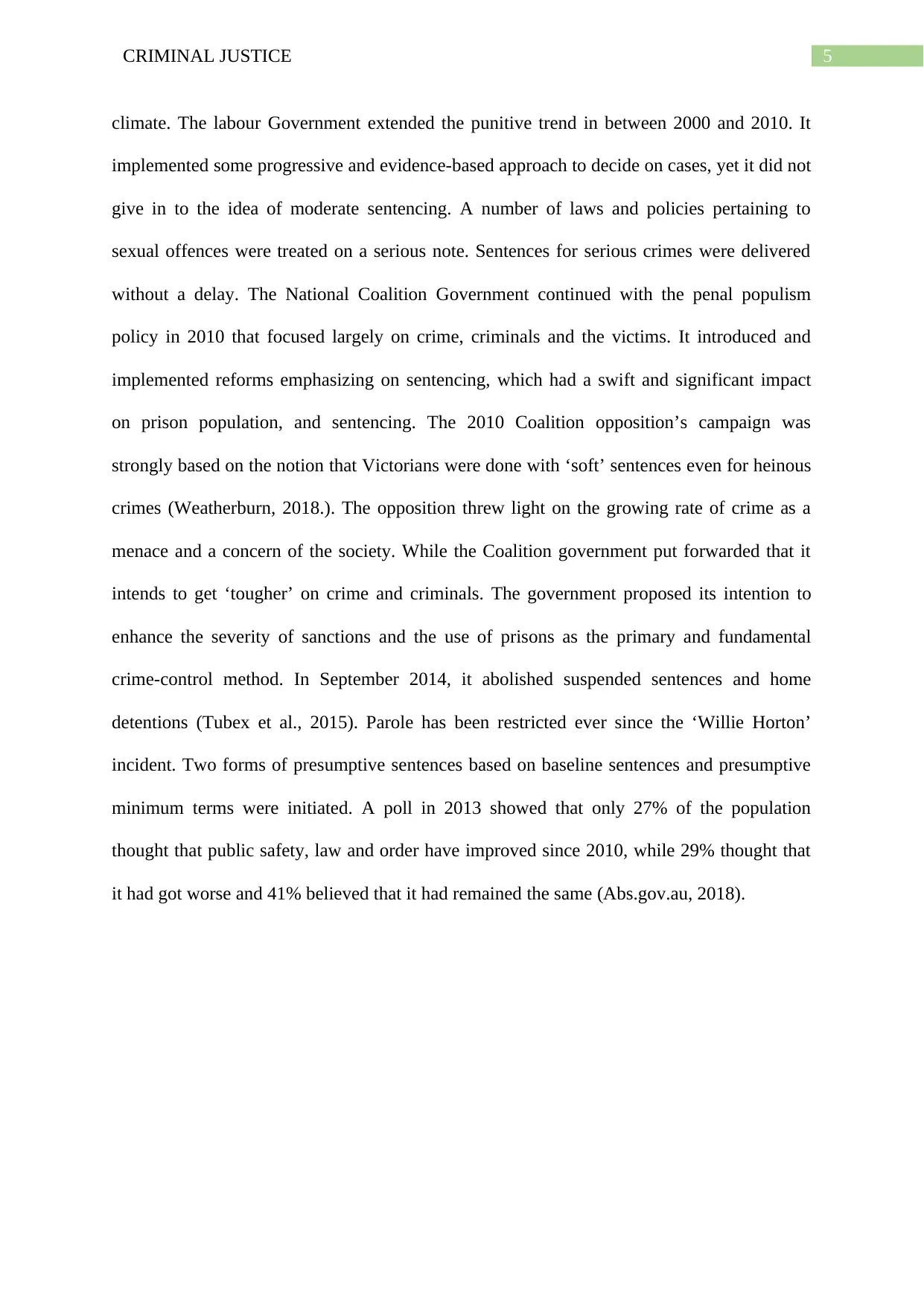Criminal Justice Perspectives: Law, Populism, and Community Sanctions
VerifiedAdded on 2023/06/08
|10
|2175
|129
Essay
AI Summary
This essay delves into the distinctions between law and justice, highlighting law as a tool for achieving justice while justice embodies fairness and morality. It further examines the effects of penal populism, where political competition leads to harsh crime measures, impacting prison populations and sentencing policies, particularly in countries like Australia. Lastly, the essay discusses instances where community-based sanctions are favored over imprisonment, especially for first-time offenders, juveniles, and those with substance abuse issues, emphasizing rehabilitation and avoiding the negative impacts of incarceration. The document is available on Desklib, a platform offering study tools and solved assignments for students.

Running head: CRIMINAL JUSTICE
Criminal Justice
Name of the Student
Name of the University
Author Name
Criminal Justice
Name of the Student
Name of the University
Author Name
Paraphrase This Document
Need a fresh take? Get an instant paraphrase of this document with our AI Paraphraser

1CRIMINAL JUSTICE
Table of Contents
Question 1: Difference between Law and Justice............................................................................
Question 2: Effects of Penal Populism............................................................................................
Question 3: Instances where Community sanctions preferred over Prison sanctions.....................
Table of Contents
Question 1: Difference between Law and Justice............................................................................
Question 2: Effects of Penal Populism............................................................................................
Question 3: Instances where Community sanctions preferred over Prison sanctions.....................

2CRIMINAL JUSTICE
Question 1: Difference between Law and Justice
Law and justice are the two sides of the same coin. Many a times they are used as
synonyms. Law is the instrument or tool to deliver justice. Law denotes the rules and
regulations, which are to be followed to maintain order and discipline in a civilized society.
Law and justice, even though have certain similarities and quite a few dissimilarities, they
have a significant part to play in the legal system of every modern country. Law is the
instrument or tool that we use and have been using for thousands of year as a method to seek
justice (Hart, 2017). It has been a long way since the Hammurabi code and the Babylonian
law, the concept of law and justice has evolved and has taken a solid shape in today’s world.
The outlook on the concepts of law and justice has reformed. Nevertheless, the crux of the
matter is that whether society and legal system has gotten nearer to the sublime phenomenon
that is ‘Justice’. Law and Justice both are a part of the society as they embolden morality and
ethics in people and eventually strikes a balance in the community. According to Plato, the
Greek philosopher, law should ensure justice and inner harmony in the state. He said that law
and justice is nothing but a moral educator of the people and society, at large. They are
supplementary to each other, as one cannot exist in absence of the other (Goldman and
Cropanzano, 2015).
It is the process or the way of attaining them, that keeps them different from each
other. Laws are written codes, rules or regulations that strive to achieve peace and order in
the society by keeping men far from wrong and deviant behavior. Some laws have a universal
appeal, while some other have cultural influences. Traditionally, law have been an instrument
of the government to ensure obedience and compliance from the people of the society. Laws
can be partial and derogatory as they are nothing but sanctions backed by the government,
police and court, which are the three pillars of the society, which is the legislature, the
Question 1: Difference between Law and Justice
Law and justice are the two sides of the same coin. Many a times they are used as
synonyms. Law is the instrument or tool to deliver justice. Law denotes the rules and
regulations, which are to be followed to maintain order and discipline in a civilized society.
Law and justice, even though have certain similarities and quite a few dissimilarities, they
have a significant part to play in the legal system of every modern country. Law is the
instrument or tool that we use and have been using for thousands of year as a method to seek
justice (Hart, 2017). It has been a long way since the Hammurabi code and the Babylonian
law, the concept of law and justice has evolved and has taken a solid shape in today’s world.
The outlook on the concepts of law and justice has reformed. Nevertheless, the crux of the
matter is that whether society and legal system has gotten nearer to the sublime phenomenon
that is ‘Justice’. Law and Justice both are a part of the society as they embolden morality and
ethics in people and eventually strikes a balance in the community. According to Plato, the
Greek philosopher, law should ensure justice and inner harmony in the state. He said that law
and justice is nothing but a moral educator of the people and society, at large. They are
supplementary to each other, as one cannot exist in absence of the other (Goldman and
Cropanzano, 2015).
It is the process or the way of attaining them, that keeps them different from each
other. Laws are written codes, rules or regulations that strive to achieve peace and order in
the society by keeping men far from wrong and deviant behavior. Some laws have a universal
appeal, while some other have cultural influences. Traditionally, law have been an instrument
of the government to ensure obedience and compliance from the people of the society. Laws
can be partial and derogatory as they are nothing but sanctions backed by the government,
police and court, which are the three pillars of the society, which is the legislature, the
⊘ This is a preview!⊘
Do you want full access?
Subscribe today to unlock all pages.

Trusted by 1+ million students worldwide

3CRIMINAL JUSTICE
executive and the judiciary (Okafo, 2016). On the other hand, the legal system, which
includes the courts and the lawyers, is dependent upon the concept of Justice. Justice means
fairness. It refers to being right, just and fair in every sense. Although justice is seemed to be
delivered in a court of law, however, it has a broader sense than that. The judgment passed by
the court of law must seem fair and right, not just lawfully correct (Sampford and Zifcak,
2016). Therefore, it can be concluded that law is a tool or an instrument to serve justice,
while justice means fair and right. Justice is the other name for ethics and morality that are
constant through eternity, while law denotes the written enactments, which can be amended
and repealed as per choice. Law has e concrete tangible structure; on the other hand, the
concept of justice is abstract. Therefore, justice is often related to the divine pronouncement
while laws are just mere rules and regulations laid down by the government.
executive and the judiciary (Okafo, 2016). On the other hand, the legal system, which
includes the courts and the lawyers, is dependent upon the concept of Justice. Justice means
fairness. It refers to being right, just and fair in every sense. Although justice is seemed to be
delivered in a court of law, however, it has a broader sense than that. The judgment passed by
the court of law must seem fair and right, not just lawfully correct (Sampford and Zifcak,
2016). Therefore, it can be concluded that law is a tool or an instrument to serve justice,
while justice means fair and right. Justice is the other name for ethics and morality that are
constant through eternity, while law denotes the written enactments, which can be amended
and repealed as per choice. Law has e concrete tangible structure; on the other hand, the
concept of justice is abstract. Therefore, justice is often related to the divine pronouncement
while laws are just mere rules and regulations laid down by the government.
Paraphrase This Document
Need a fresh take? Get an instant paraphrase of this document with our AI Paraphraser

4CRIMINAL JUSTICE
Question 2: Effects of Penal Populism
Penal populism is the phenomenon where political parties of a country compete with
each other to adopt harsh and deterrent measures for crime. The concept of penal populism
refers to the disenchantment perceived by a specific section of the society. It is the crime
victims and their family members or their representatives who feels to be left out and
forgotten by the justice system that focuses more on the offender than on the victim. Prison
population increases in those countries where penal populism makes its way. Developed
countries like the USA, UK, New Zealand, Canada and Australia have a strong presence of
penal populism. Government bodies propagate penal policies in accordance with their
aspiration and commitment towards common people rather than focusing on the concept of
fair justice. In today’s world, common public as well as policy makers largely depends on the
highlights of the media pertaining to crime. With the growing media and public
consciousness, concepts like penal populism is evolving and taking a strong shape as well. It
has changed the face of criminal sanction theories and opinion of common people on crime
and punishment. It has laid down new policies and agendas relating to crime (Freiberg and
Gelb, 2014).
In Australia, prison numbers increased in the 70s due to the advancing crime rates,
however from the 90s, things changed due to the growing concept of penal populism.
Although it did not mark a change on the judicial sentencing system, but there was a
significant increase of the prison numbers. Nevertheless, since early 90s reform activities
started to take place and in 1991 a Labour Government struck down ‘remission’ to establish
‘truth’ in sentencing even though the effects were not significant enough. A Conservative
Government between 1993 and 1999 introduced some policies and regulations for recidivist,
violent and sexual offenders. These policies helped enhancing the rigidity of the prison
Question 2: Effects of Penal Populism
Penal populism is the phenomenon where political parties of a country compete with
each other to adopt harsh and deterrent measures for crime. The concept of penal populism
refers to the disenchantment perceived by a specific section of the society. It is the crime
victims and their family members or their representatives who feels to be left out and
forgotten by the justice system that focuses more on the offender than on the victim. Prison
population increases in those countries where penal populism makes its way. Developed
countries like the USA, UK, New Zealand, Canada and Australia have a strong presence of
penal populism. Government bodies propagate penal policies in accordance with their
aspiration and commitment towards common people rather than focusing on the concept of
fair justice. In today’s world, common public as well as policy makers largely depends on the
highlights of the media pertaining to crime. With the growing media and public
consciousness, concepts like penal populism is evolving and taking a strong shape as well. It
has changed the face of criminal sanction theories and opinion of common people on crime
and punishment. It has laid down new policies and agendas relating to crime (Freiberg and
Gelb, 2014).
In Australia, prison numbers increased in the 70s due to the advancing crime rates,
however from the 90s, things changed due to the growing concept of penal populism.
Although it did not mark a change on the judicial sentencing system, but there was a
significant increase of the prison numbers. Nevertheless, since early 90s reform activities
started to take place and in 1991 a Labour Government struck down ‘remission’ to establish
‘truth’ in sentencing even though the effects were not significant enough. A Conservative
Government between 1993 and 1999 introduced some policies and regulations for recidivist,
violent and sexual offenders. These policies helped enhancing the rigidity of the prison

5CRIMINAL JUSTICE
climate. The labour Government extended the punitive trend in between 2000 and 2010. It
implemented some progressive and evidence-based approach to decide on cases, yet it did not
give in to the idea of moderate sentencing. A number of laws and policies pertaining to
sexual offences were treated on a serious note. Sentences for serious crimes were delivered
without a delay. The National Coalition Government continued with the penal populism
policy in 2010 that focused largely on crime, criminals and the victims. It introduced and
implemented reforms emphasizing on sentencing, which had a swift and significant impact
on prison population, and sentencing. The 2010 Coalition opposition’s campaign was
strongly based on the notion that Victorians were done with ‘soft’ sentences even for heinous
crimes (Weatherburn, 2018.). The opposition threw light on the growing rate of crime as a
menace and a concern of the society. While the Coalition government put forwarded that it
intends to get ‘tougher’ on crime and criminals. The government proposed its intention to
enhance the severity of sanctions and the use of prisons as the primary and fundamental
crime-control method. In September 2014, it abolished suspended sentences and home
detentions (Tubex et al., 2015). Parole has been restricted ever since the ‘Willie Horton’
incident. Two forms of presumptive sentences based on baseline sentences and presumptive
minimum terms were initiated. A poll in 2013 showed that only 27% of the population
thought that public safety, law and order have improved since 2010, while 29% thought that
it had got worse and 41% believed that it had remained the same (Abs.gov.au, 2018).
climate. The labour Government extended the punitive trend in between 2000 and 2010. It
implemented some progressive and evidence-based approach to decide on cases, yet it did not
give in to the idea of moderate sentencing. A number of laws and policies pertaining to
sexual offences were treated on a serious note. Sentences for serious crimes were delivered
without a delay. The National Coalition Government continued with the penal populism
policy in 2010 that focused largely on crime, criminals and the victims. It introduced and
implemented reforms emphasizing on sentencing, which had a swift and significant impact
on prison population, and sentencing. The 2010 Coalition opposition’s campaign was
strongly based on the notion that Victorians were done with ‘soft’ sentences even for heinous
crimes (Weatherburn, 2018.). The opposition threw light on the growing rate of crime as a
menace and a concern of the society. While the Coalition government put forwarded that it
intends to get ‘tougher’ on crime and criminals. The government proposed its intention to
enhance the severity of sanctions and the use of prisons as the primary and fundamental
crime-control method. In September 2014, it abolished suspended sentences and home
detentions (Tubex et al., 2015). Parole has been restricted ever since the ‘Willie Horton’
incident. Two forms of presumptive sentences based on baseline sentences and presumptive
minimum terms were initiated. A poll in 2013 showed that only 27% of the population
thought that public safety, law and order have improved since 2010, while 29% thought that
it had got worse and 41% believed that it had remained the same (Abs.gov.au, 2018).
⊘ This is a preview!⊘
Do you want full access?
Subscribe today to unlock all pages.

Trusted by 1+ million students worldwide

6CRIMINAL JUSTICE
Question 3: Instances where Community sanctions preferred over Prison
sanctions
Community based sanctions also known as intermediate or alternative sanctions is a
popular form of punishment spread all over the western society. Introduction of community-
based sanction has been one of the significant development in sentencing system in most of
the developed countries. It has up-turned the outlook on the concepts of crime, criminals,
crime victims, sentencing and the community as a whole. It paved its way into the legal
system due to the ever-growing prison population because of the increasing crime rate and
the intensity of the crimes. While a few other reasons are pointed out as well for the
emergence of community sanctions. It is often put forwarded that prison fails to rehabilitate
offenders or create deterrence in the offender’s mind (Alrc.gov.au, 2018). Most of the times it
has been seen that a first time offender has greater risk to fall into the crime world and
become a habitual offender. Therefore, community sanction, which is a positive alternative
for jail sentences, works better for juveniles or first time offenders (Alarid, L.F., 2016).
It is important to segregate offenders as per their offences as that would help in
installing better reformative changes in the inmates. Possible sex offenders need to be treated
cautiously, understanding their psychological issues by using a compassionate and
counselling approach. Therefore, sex offending should be treated within the ambit of public
health domain. Similarly, incarcerating mothers should be prescribes alternative sanctions as
their children are dependent on them. Therefore, such women should either be give a shorter
sentence or a community service one, which would let her be with the children. While parents
that adversely affect the children should be sent for probation to serve in a community service
(Hedderman and Jolliffe, 2015). As for petty crimes like drinking driving or substance abuse
or petty theft, community based sanctions prove to be better than prison sentencing as they do
Question 3: Instances where Community sanctions preferred over Prison
sanctions
Community based sanctions also known as intermediate or alternative sanctions is a
popular form of punishment spread all over the western society. Introduction of community-
based sanction has been one of the significant development in sentencing system in most of
the developed countries. It has up-turned the outlook on the concepts of crime, criminals,
crime victims, sentencing and the community as a whole. It paved its way into the legal
system due to the ever-growing prison population because of the increasing crime rate and
the intensity of the crimes. While a few other reasons are pointed out as well for the
emergence of community sanctions. It is often put forwarded that prison fails to rehabilitate
offenders or create deterrence in the offender’s mind (Alrc.gov.au, 2018). Most of the times it
has been seen that a first time offender has greater risk to fall into the crime world and
become a habitual offender. Therefore, community sanction, which is a positive alternative
for jail sentences, works better for juveniles or first time offenders (Alarid, L.F., 2016).
It is important to segregate offenders as per their offences as that would help in
installing better reformative changes in the inmates. Possible sex offenders need to be treated
cautiously, understanding their psychological issues by using a compassionate and
counselling approach. Therefore, sex offending should be treated within the ambit of public
health domain. Similarly, incarcerating mothers should be prescribes alternative sanctions as
their children are dependent on them. Therefore, such women should either be give a shorter
sentence or a community service one, which would let her be with the children. While parents
that adversely affect the children should be sent for probation to serve in a community service
(Hedderman and Jolliffe, 2015). As for petty crimes like drinking driving or substance abuse
or petty theft, community based sanctions prove to be better than prison sentencing as they do
Paraphrase This Document
Need a fresh take? Get an instant paraphrase of this document with our AI Paraphraser

7CRIMINAL JUSTICE
not brand the offender as a criminal, rather it give them a chance to improve and go back to
normalcy. In case of Juveniles, it is substantial to direct them into community service rather
than throwing them into jails. They have a clean and bright future ahead, which might be lost
forever in the darkness of a prison cell once the minor comes in contact with habitual
offenders. Cases involving drug abuser needs special attention. Residential drug abuse
programs enables abusers to get sober and released quicker by getting rid of their addiction.
Young bloods who are first time offenders should be treated with compassion and must be
given a chance to repent. In such instances community based sanction is considered more
appropriate than prison sentencing (Bazemore and Schiff, 2015).
not brand the offender as a criminal, rather it give them a chance to improve and go back to
normalcy. In case of Juveniles, it is substantial to direct them into community service rather
than throwing them into jails. They have a clean and bright future ahead, which might be lost
forever in the darkness of a prison cell once the minor comes in contact with habitual
offenders. Cases involving drug abuser needs special attention. Residential drug abuse
programs enables abusers to get sober and released quicker by getting rid of their addiction.
Young bloods who are first time offenders should be treated with compassion and must be
given a chance to repent. In such instances community based sanction is considered more
appropriate than prison sentencing (Bazemore and Schiff, 2015).

8CRIMINAL JUSTICE
References
Abs.gov.au. (2018). 4517.0 - Prisoners in Australia, 2017. [online] Available at:
http://www.abs.gov.au/ausstats/abs@.nsf/mf/4517.0 [Accessed 13 Aug. 2018].
Alarid, L.F., 2016. Community based corrections. Cengage Learning.
Alrc.gov.au. (2018). Alternative Forms of Sentencing | ALRC. [online] Available at:
https://www.alrc.gov.au/publications/21.%20Aboriginal%20Customary%20Laws%20and
%20Sentencing/alternative-forms-sentencing [Accessed 13 Aug. 2018].
Bazemore, G. and Schiff, M., 2015. Restorative community justice: Repairing harm and
transforming communities. Routledge.
Freiberg, A., & Gelb, K. (2014). Penal populism, sentencing councils and sentencing policy.
Willan.
Goldman, B. and Cropanzano, R., 2015. “Justice” and “fairness” are not the same
thing. Journal of Organizational Behavior, 36(2), pp.313-318.
Hart, H.L.A., 2017. Positivism and the Separation of Law and Morals. In Law and
Morality (pp. 63-99). Routledge.
Hedderman, C. and Jolliffe, D., 2015. The impact of prison for women on the edge: paying
the price for wrong decisions. Victims & Offenders, 10(2), pp.152-178.
Okafo, N., 2016. Reconstructing law and justice in a postcolony. Routledge.
References
Abs.gov.au. (2018). 4517.0 - Prisoners in Australia, 2017. [online] Available at:
http://www.abs.gov.au/ausstats/abs@.nsf/mf/4517.0 [Accessed 13 Aug. 2018].
Alarid, L.F., 2016. Community based corrections. Cengage Learning.
Alrc.gov.au. (2018). Alternative Forms of Sentencing | ALRC. [online] Available at:
https://www.alrc.gov.au/publications/21.%20Aboriginal%20Customary%20Laws%20and
%20Sentencing/alternative-forms-sentencing [Accessed 13 Aug. 2018].
Bazemore, G. and Schiff, M., 2015. Restorative community justice: Repairing harm and
transforming communities. Routledge.
Freiberg, A., & Gelb, K. (2014). Penal populism, sentencing councils and sentencing policy.
Willan.
Goldman, B. and Cropanzano, R., 2015. “Justice” and “fairness” are not the same
thing. Journal of Organizational Behavior, 36(2), pp.313-318.
Hart, H.L.A., 2017. Positivism and the Separation of Law and Morals. In Law and
Morality (pp. 63-99). Routledge.
Hedderman, C. and Jolliffe, D., 2015. The impact of prison for women on the edge: paying
the price for wrong decisions. Victims & Offenders, 10(2), pp.152-178.
Okafo, N., 2016. Reconstructing law and justice in a postcolony. Routledge.
⊘ This is a preview!⊘
Do you want full access?
Subscribe today to unlock all pages.

Trusted by 1+ million students worldwide

9CRIMINAL JUSTICE
Sampford, C. and Zifcak, S., 2016. Rethinking international law and justice. Routledge.
Tubex, H., Brown, D., Freiberg, A., Gelb, K. and Sarre, R., 2015. Penal diversity within
Australia. Punishment & Society, 17(3), pp.345-373.
Weatherburn, D., 2018. Australian imprisonment 2002–2016: Crime, policing and penal
policy. Australian & New Zealand Journal of Criminology, p.0004865818757585.
Sampford, C. and Zifcak, S., 2016. Rethinking international law and justice. Routledge.
Tubex, H., Brown, D., Freiberg, A., Gelb, K. and Sarre, R., 2015. Penal diversity within
Australia. Punishment & Society, 17(3), pp.345-373.
Weatherburn, D., 2018. Australian imprisonment 2002–2016: Crime, policing and penal
policy. Australian & New Zealand Journal of Criminology, p.0004865818757585.
1 out of 10
Related Documents
Your All-in-One AI-Powered Toolkit for Academic Success.
+13062052269
info@desklib.com
Available 24*7 on WhatsApp / Email
![[object Object]](/_next/static/media/star-bottom.7253800d.svg)
Unlock your academic potential
Copyright © 2020–2025 A2Z Services. All Rights Reserved. Developed and managed by ZUCOL.



